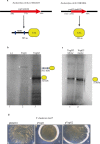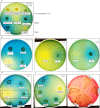Absence of Global Stress Regulation in Escherichia coli Promotes Pathoadaptation and Novel c-di-GMP-dependent Metabolic Capability
- PMID: 30796316
- PMCID: PMC6385356
- DOI: 10.1038/s41598-019-39580-w
Absence of Global Stress Regulation in Escherichia coli Promotes Pathoadaptation and Novel c-di-GMP-dependent Metabolic Capability
Abstract
Pathoadaptive mutations linked to c-di-GMP signalling were investigated in neonatal meningitis-causing Escherichia coli (NMEC). The results indicated that NMEC strains deficient in RpoS (the global stress regulator) maintained remarkably low levels of c-di-GMP, a major bacterial sessility-motility switch. Deletion of ycgG2, shown here to encode a YcgG allozyme with c-di-GMP phosphodiesterase activity, and the restoration of RpoS led to a decrease in S-fimbriae, robustly produced in artificial urine, hinting that the urinary tract could serve as a habitat for NMEC. We showed that NMEC were skilled in aerobic citrate utilization in the presence of glucose, a property that normally does not exist in E. coli. Our data suggest that this metabolic novelty is a property of extraintestinal pathogenic E. coli since we reconstituted this ability in E. coli UTI89 (a cystitis isolate) via deactivation rpoS; additionally, a set of pyelonephritis E. coli isolates were shown here to aerobically use citrate in the presence of glucose. We found that the main reason for this metabolic capability is RpoS inactivation leading to the production of the citrate transporter CitT, exploited by NMEC for ferric citrate uptake dependent on YcgG2 (an allozyme with c-di-GMP phosphodiesterase activity).
Conflict of interest statement
The authors declare no competing interests.
Figures






Similar articles
-
Altered Regulation of the Diguanylate Cyclase YaiC Reduces Production of Type 1 Fimbriae in a Pst Mutant of Uropathogenic Escherichia coli CFT073.J Bacteriol. 2017 Nov 14;199(24):e00168-17. doi: 10.1128/JB.00168-17. Print 2017 Dec 15. J Bacteriol. 2017. PMID: 28924030 Free PMC article.
-
Genetic analysis of the role of yfiR in the ability of Escherichia coli CFT073 to control cellular cyclic dimeric GMP levels and to persist in the urinary tract.Infect Immun. 2013 Sep;81(9):3089-98. doi: 10.1128/IAI.01396-12. Epub 2013 Jun 17. Infect Immun. 2013. PMID: 23774594 Free PMC article.
-
Cyclic-di-GMP-mediated signalling within the sigma network of Escherichia coli.Mol Microbiol. 2006 Nov;62(4):1014-34. doi: 10.1111/j.1365-2958.2006.05440.x. Epub 2006 Sep 29. Mol Microbiol. 2006. PMID: 17010156
-
Analysis of the sfaX(II) locus in the Escherichia coli meningitis isolate IHE3034 reveals two novel regulatory genes within the promoter-distal region of the main S fimbrial operon.Microb Pathog. 2009 Mar;46(3):150-8. doi: 10.1016/j.micpath.2008.12.001. Epub 2008 Dec 13. Microb Pathog. 2009. PMID: 19103276
-
Genome-Based Comparison of Cyclic Di-GMP Signaling in Pathogenic and Commensal Escherichia coli Strains.J Bacteriol. 2015 Aug 24;198(1):111-26. doi: 10.1128/JB.00520-15. Print 2016 Jan 1. J Bacteriol. 2015. PMID: 26303830 Free PMC article.
Cited by
-
Strategies to Tackle Antimicrobial Resistance: The Example of Escherichia coli and Pseudomonas aeruginosa.Int J Mol Sci. 2021 May 6;22(9):4943. doi: 10.3390/ijms22094943. Int J Mol Sci. 2021. PMID: 34066555 Free PMC article. Review.
-
Comparative label-free proteomics of the neonatal meningitis-causing Escherichia coli K1 IHE3034 and RS218 morphotypes.Microbiol Resour Announc. 2024 Feb 15;13(2):e0096023. doi: 10.1128/mra.00960-23. Epub 2024 Jan 30. Microbiol Resour Announc. 2024. PMID: 38289054 Free PMC article.
-
Characterisation of Variants of Cyclic di-GMP Turnover Proteins Associated with Semi-Constitutive rdar Morphotype Expression in Commensal and Uropathogenic Escherichia coli Strains.Microorganisms. 2023 Aug 9;11(8):2048. doi: 10.3390/microorganisms11082048. Microorganisms. 2023. PMID: 37630608 Free PMC article.
-
Detection of extended-spectrum β-lactamase-producing Escherichia coli genes isolated from cat rectal swabs at Surabaya Veterinary Hospital, Indonesia.Vet World. 2023 Sep;16(9):1917-1925. doi: 10.14202/vetworld.2023.1917-1925. Epub 2023 Sep 21. Vet World. 2023. PMID: 37859949 Free PMC article. Review.
-
Evolution of cyclic di-GMP signalling on a short and long term time scale.Microbiology (Reading). 2023 Jun;169(6):001354. doi: 10.1099/mic.0.001354. Microbiology (Reading). 2023. PMID: 37384391 Free PMC article.
References
-
- Boone, D. R., Castenholz, R. W. & Garrity, G. M. Bergey’s manual of systematic bacteriology. 2nd edn, (Springer, 2001).
Publication types
MeSH terms
Substances
LinkOut - more resources
Full Text Sources

